An Overview to Thermal Weed Treatments
The demand for thermal weed control has increased alongside public pressure and tighter rules and regulations around the use of synthetic chemical weed killers, but there are stand alone benefits
All thermal weed treatments are using thermal shock to kill targeted weeds. The temperature of the weed is increased rapidly to a point where its cells are destroyed and it will no longer photosynthesise. While each process does this slightly differently, the theory is the same.
Each weed type and its environment and surroundings will bring different challenges, meaning you will need to choose the treatment type that is best suited for you.
How it works:
To kill a plant thermally you are looking to achieve total cell destruction. Temperature in the weed is increased, either through natural resistance or exposure to high temperatures. Once the plant/weed reaches above 75/80 degrees C. the effects are; proteins denaturing, membranes breaking down, and essential enzymes become inactive, leading to a collapse of cellular organization and irreversible cell death after which photosynthesis is no longer possible.
Thermal options:
Electricity - The weeds naturally try to resist the electricity, this reaction naturally raises the temperature in the plant above the key temperature of 75-80 degrees C, boiling the plant from the inside out. Stream is produced and you can hear the popping and crackling as the cells in the plant burst. Then, electricity naturally wants to find earth, to do this it travels down the roots of the plant, and forms a circuit with a return electrode making it a systemic kill.
Current in the ground is very low as it dissipates in thousands of different routes back to the return electrode. What you touch is what you kill, the treatment electrode needs to make contact with a plant to kill it. Surrounding plants are left intact, no microbiomes are damaged in the soil.

Hot Water - The water is delivered at low pressure at temperatures between 95 and 100 degrees C, this wilts the weed above ground, raising the temperature of the cells in the plant past the target temperature of 75-80 degrees C. The hot water penetrates the ground and uses the soil as an insulator, cooking the roots below the surface. The water is delivered at low pressure to retain its heat, the water droplets are larger and stay hotter for longer, this also gives better coverage of the plant. A short distance between the treatment nozzle and the plant will also ensure more heat is retained.
With a water filter, harvested rain water or water from natural water sources can be used, really rubber stamping the sustainability of this process. This treatment is very versatile and can be used to kill weeds in a wide range of situations, from hard standing in high traffic areas, through to weeds growing in around water courses, where chemical usage is restricted.
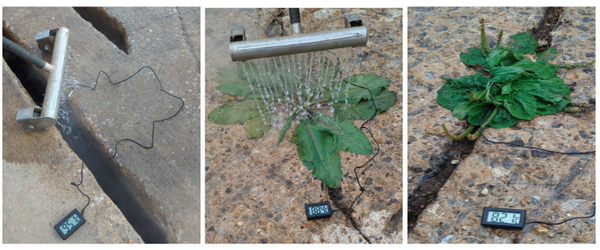
Hot Air - Using the heat created by a flame, the hot air blast reaches 300°c, this is used to heat the plant above the magic number of 75-80 degrees and stop photosynthesis. Using the hot air rather than the flame itself is best practice, giving the best results. Germinating seeds exposed to the heat will also be killed in the process. For best results you should repeat the treatments within two weeks.
It is a very clean and efficient burn, using 6% propane gas and 94% air. This process is best suited to small weeds with small root systems, where the heat can be transferred through the plant easily. It is a very compact and mobile system, giving access around everyday obstacles such as street furniture.
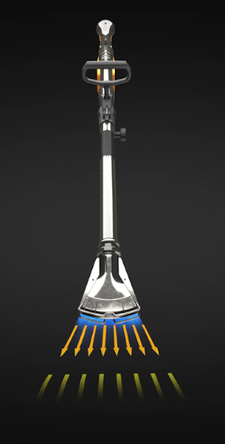
Treated weeds will be dead as soon as they have been heated above 75-80 degrees C. Visual evidence will differ slightly between treatments, but there is always clear evidence that treatment has been successful.
Hot water will wilt the plant above the ground, seeing it going limp, very similar to boiling vegetables. You will see the plant soften and go limp. Over the next 24 - 48 hours the weed will brown off and start to decompose.
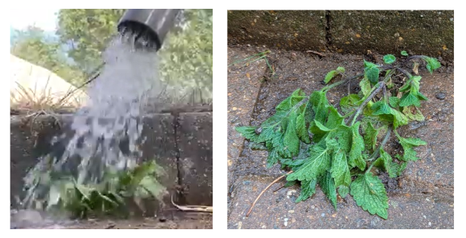
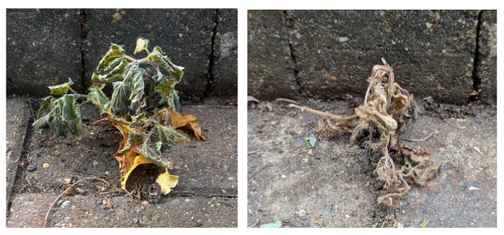
1. During Treatment - 2. Immediatley After Treatment - 3. 24 Hours After Treatment - 4. 1 Week After Treatment
Hot Air bruises the leaf in the first instance, and the weed is noticeably darker in colour. A pinch test gives you quick clear results. Take the leaf between your thumb and forefinger, and pinch, if the cells are damaged enough to kill the plant, you will leave a finger print mark. Try the same on a live plant and you will not leave a mark. You will then see the plant brown and die off, as with other treatments.
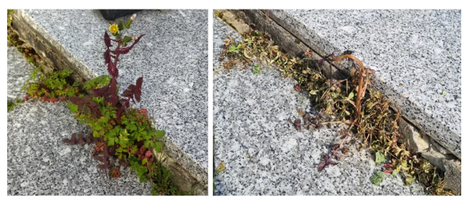
Before and After Hot Air Treatment.
Electricity will also give instant signs of effective treatment. The leaves of the plant will change colour and bruise, again the pinch test will also work on treated plants. Larger plants will fall over and lose structure. Once any weed is killed it will brown off and start to rot and decay.

Before Treatmet - Immeadiately After Treatment - 1 Week After Treatment
With thermal treatment of weeds your treatment window vastly widened. As soon as a weed is visible it can be treated, all year round. Treatments will be quickest and most effective earlier in the weeds growth. When a weed is small it will use less energy to kill it, also the plant will still be putting its energy into growth above ground, and have a smaller root system, again taking less time and energy to take effect.
The only restriction to treatment is using the Electrical product in direct rainfall. Otherwise all treatments can take place all year round and in all weather conditions.
If you need help finding which method is right for you, or would like to see one or more of these in action in your specific environment, please don’t hesitate to contact one of our experts, we would only be happy to help.
No comments yet. Login to start a new discussion Start a new discussion